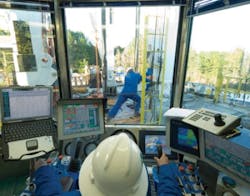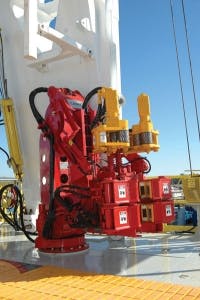Even though more than 1,000 rigs are inactive in the US, drilling contractors are building new land rigs to satisfy operator demand for improved technology.
In the case of Nabors Drilling USA LP, Ronnie Witherspoon, senior vice-president marketing and business development, said that for newbuilds operators are requesting Nabors new AC rigs for their drilling programs, especially for drilling in unconventional basins.
He said, "To meet demand we are expanding our fleet with the new PACE rigs." Typically Nabors only builds new PACE rigs when customers make a long-term contractual commitment, he added.
PACE stands for programmable AC electric and the programmable refers to various functions and controls that are programmed in the rig's PLCs (programmable logic controllers), Witherspoon explained.
The automation in these rigs includes a drawworks-control joystick for raising, lowering, and stopping the traveling blocks. Drillers input all other drawworks operating parameters such as upper and lower hoist limits and speed, via a human-machine interface screen that controls the PLC and variable-frequency drive systems (Fig. 1).
These rigs have a top-drive joystick that operates the pipe handler rotation, link tilt extend-retract, and makeup and breakout functions. Drillers also use the HMI screens for operating and monitoring other equipment such as mud pumps, blowout preventer accumulator system, torque wrench, rotary table, catheads, and hydraulic power unit.
Witherspoon noted that before AC technology, joysticks were primarily utilized for drawworks braking applications.
Rig models
Nabor's more recently built rigs include the M-series rigs (Fig. 2) that drill in a broad range of depths and in a variety of geographical and geophysical areas. These rigs have a small footprint that allows them to operate on locations with limited space for drilling single wells or multiple wells from a single pad. Nabors deployed the first M-series rig in fourth-quarter 2006.
| Nabor's M-series rigs (left photo) can operate on locations with limited space (Fig. 2). One feature on the PACE rigs (middle photo) is an automated iron roughneck (Fig. 3). The PACE rigs (right photo) have automated catwalk pipe handling systems (Fig. 4). |
Witherspoon said different PACE rigs series are built for specific markets such as:
• PACE B-series, 1,500-hp rig with a skid system for the Bakken.
• PACE F-series and PACE 1500, 1,500-hp rig suited for the Haynesville and Eagle Ford shales.
• PACE Super Sundowner, 1,000-hp rig designed for pad drilling in the Rocky Mountains. The rigs can drill up to 22 wells from one well pad.
• PACE Academy, 1,000-hp rig built by Nabors in Canada for winterized drilling in Colorado, Wyoming, and North Dakota.
• PACE AC Hybrid Coil Tubing, PACE technology deployed in a coiled-tubing rig for shallow gas wells and deeper reentry drilling.
Witherspoon said Nabors first began building PACE rigs in 2005 and to date has built more than 200. The US total is 98 PACE drilling rigs and 1 coiled-tubing rig, with 53 M-series rigs, including 4 that Nabors will deploy in 2010, he said.
He added that in 2010, Nabors will also deploy two Box-on-Box PACE rigs, which is a rig specifically designed for the Bakken play in North Dakota.
Most PACE rigs are currently on contract including the 53 PACE M-series rigs with most of the M-series rigs working in the Haynesville shale and the remainder in shale plays such as the Marcellus, Eagle Ford, Fayetteville, and Barnett, as well as the tight gas sands in the Piceance basin in Colorado.
The PACE rigs typically are for drilling horizontal wells that range from 8,000 to 11,000 ft TVD with laterals that range from 3,000 to 6,000 ft.
Main features
Some of the main features of these rigs include:
• Mast and substructure design that allows for transportation in four loads for the rig, including the drawworks, rotary table, iron roughneck, traveling blocks, and top drive.
• Use of PLCs for monitoring and automatically controlling the hydraulic cylinders for raising the mast and substructure.
• Drawworks that rotate 90° on the drill floor to allow installation and transportation on the substructure center steel.
• 142-ft telescoping mast with integrated top drive.
• Custom-designed BOP handling and transportation system.
• Automated iron roughneck (Fig. 3).
• Automated catwalk pipe-handling system (Fig. 4).
Also available on the rigs is the Rockit, Canrig Drilling Technology Ltd.'s surface rotary steerable system for aiding directional drilling by increasing penetration rates during sliding, providing faster tool-face settings, and improving tool-face control.
All M-Series rigs can accommodate multiwell pad drilling and an optional walking system can enhance the move capability with full setback.
AC rigs
Nabors said that it is only building new AC rigs. The company notes that some competitors build new DC rigs, but "the way of the future is AC technology and we cannot justify large capital expenditures on new non-AC rigs, when that capital could more strategically be deployed toward the development and construction of PACE rigs."
Nabors says AC technology makes it easier to provide precise and automated rig controls such as:
• Drawworks efficiency and safety with a single joystick operation and effective autodrill function.
• Top-drive directional drilling efficiency.
• Mud pump speed and pressure controls.
• Improved drilling and tripping performance
• Reduced nonproductive time on well.
AC-driven equipment is smaller, more portable, and offers enhanced performance and reliability. DC motors cannot operate at zero speed for extended periods, while AC motors can run at zero and low speeds at full torque for prolonged extended periods.
The drawworks and top drives benefit operationally from the AC motor's ability to hold full torque and load at zero speed for extended periods. For instance, regeneration converts kinetic energy to electrical energy, enabling the motor to slow and stop rotation. This eliminates the need for separate eddy current and service brakes on drawworks.
Another difference is that DC motors require brushes for rotor current. AC motors are brushless, thereby requiring less maintenance, and are more suited for hazardous locations.
AC drives also improve the power factor and increase the overall efficiency. DC motor-drive systems have a varying power factor based on speed (0.30-0.95). AC motor-drive systems have a constant 0.95 power factor at all speeds.
More Oil & Gas Journal Current Issue Articles
More Oil & Gas Journal Archives Issue Articles
View Oil and Gas Articles on PennEnergy.com




